Low and zero-carbon vehicles for urban last-mile deliveries
Low and zero-carbon vehicles for urban last-mile deliveries
By Melanie Troppe & Günther Illek (IFZ), and Lorena Axinte & Nacho Sarrió (Bax & Company).
Low and zero-carbon vehicles are a key element of most sustainable urban last-mile logistics solutions today and are gaining more and more presence and relevance. In this ULaaDS insight, we take a look at the three main types of vehicles for use in an urban context: Cargo bikes, Light Electric Vehicles (LEVs), and e-vans. We’ve also included an analysis of their pros and cons according to the needs of the logistics framework in which they should be implemented.
LEV, e-Van, eLCV – A short excursion into nomenclature
Commonly interchanged, here is some clarification:
– LEV: Light electric vehicles are small vehicles weighing less than 100kg that run on electricity.
– E-van: Regular-sized vans that run on electricity instead of petrol and an internal combustion engine.
– eLCV: Electric light commercial vehicles – used for commercial purposes, they have a gross vehicle weight of no more than 3.5 metric tonnes – defined by the EU as an N1 vehicle*
Conclusion: The term eLCV encompasses both e-vans and LEVs.
*N1 vehicles are further subdivided into three classes: Small (N1-I, gross weight: ≤ 1305 kg), Medium (N1-II, gross weight: 1305-1760 kg), Large (N1-III, gross weight: 1760-3500 kg).
What vehicles are available?
Cargo bikes: Affordable or inefficient solution?
In recent years, more focus has been put on the rediscovery of cargo bikes for sustainable urban logistics solutions, in line with early suggestions made by Wright and Reiter in 2016. They stated that up to 25% of motorised logistics pickup and delivery trips can be replaced by cargo bike use. This number has not yet been reached but there is strong momentum towards cargo bike use for first and last-mile delivery. In short: cargo bikes have a long history but have been given a push in the last decade.
The ideal bike model will depend on the required load and type of products that must be carried. the heavier the load that needs to be carried, the more wheels needed to better distribute the weight. Additionally, electric cargo bikes are also commonly used to cope with heavier loads, as well as to navigate hilly areas. Compared to regular cargo bikes, where the endurance of the cyclist determines the possible distance, the range of e-cargo bikes mainly depends on the capacity of the battery. This range varies between 20-100km.
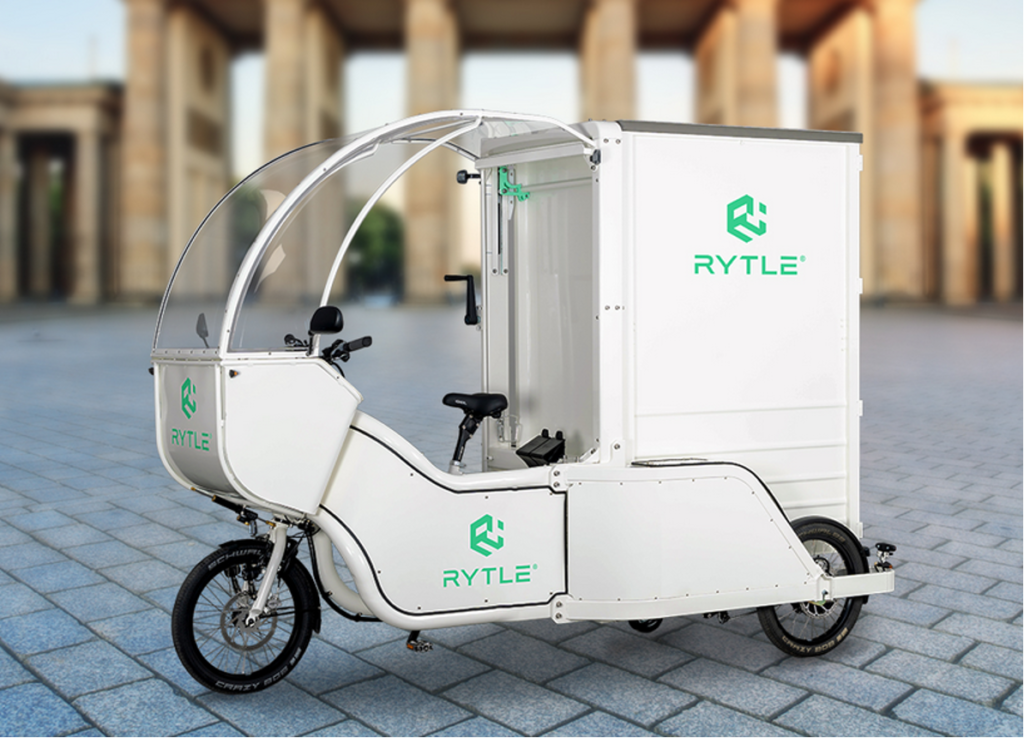
See below our overview of cargo bike types according to their shape, load distribution, and number of wheels, which all influence driving behaviour and possibilities. Three and four-wheelers have the advantage that they are more stable in adverse weather conditions, but other than that, they are usually more prone to overturning around bends/corners at high speeds, compared to two-wheelers. Furthermore, transverse forces come into play here, as the wheels of three and four-wheelers stay upright when turning. Spoked wheels are often not built for these forces and therefore can increase maintenance costs. To avoid abrasion, ULaaDS partner Bpost uses a notable alternative; postal delivery bikes with trailers. Another way to reduce this wear would be to fit the wheels with plastic rims. This increases the weight but leads to a higher load capacity for the wheels.
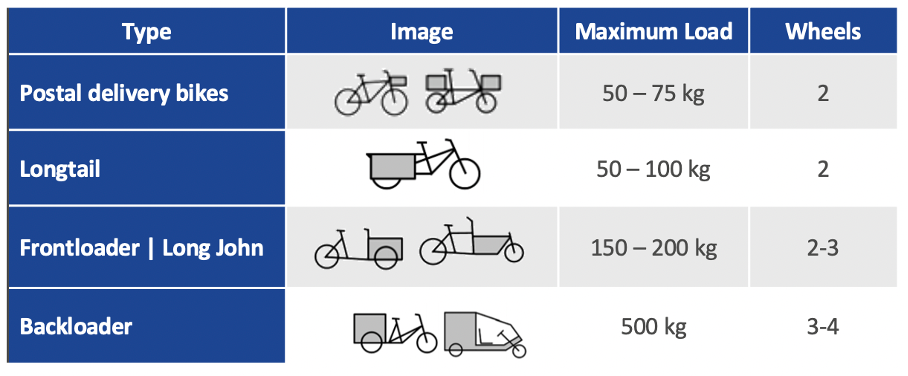
Cargo bikes vs trailers
Trailers are a great option to further increase the loading capacities of regular bikes and cargo bikes. Depending on the trailer model, up to 150 kg of weight can be loaded onto this add-on. With the extra load, it is essential that the bike is robust, with a well-functioning braking system. Additionally, the trailer has the advantage that it can be handled manually for shorter trips at the destination, making it much more flexible than regular cargo bikes with fixed cargo areas.
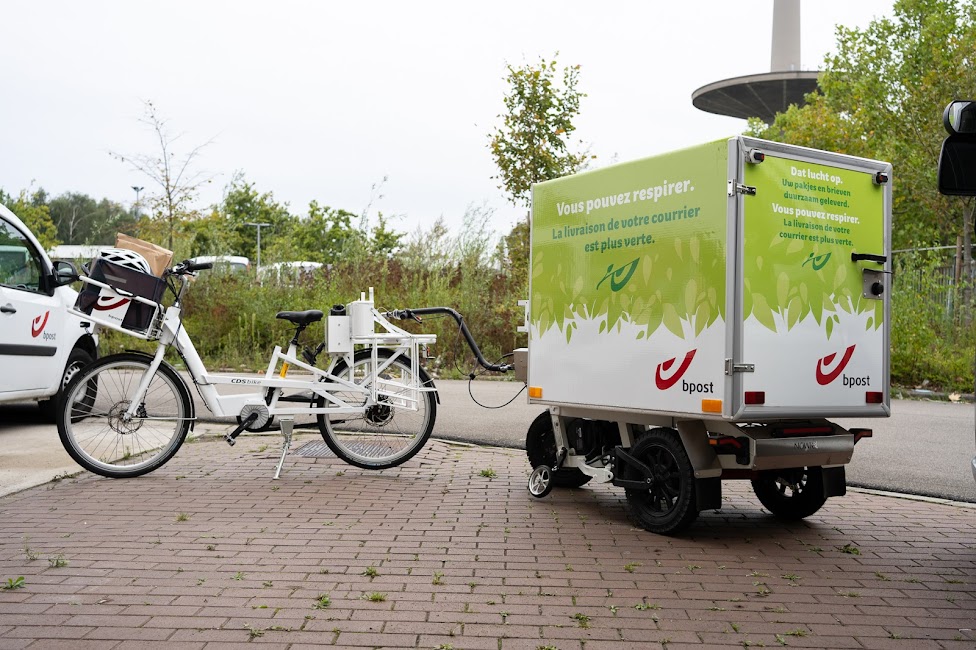
LEVs: Small and flexible choice
Light Electric Vehicle is a term for a variety of small electric vehicles with a weight of less than 100 kg, most often built for very specific purposes. They are widely recognised due to their use by postal services, for instance. One of the main advantages is their size, allowing for greater flexibility and the possibility of using city cycling infrastructure – if the national legal framework allows its use. One of the size disadvantages is that more trips are needed to deliver many parcels, which could be transported by one van load. Therefore, additional infrastructure, such as hubs will be needed for efficient urban logistics.
E-vans: Traditional solutions reinvented
From a logistics service provider point of view, it makes sense to start a transition to more sustainable logistics with e-vans. By replacing the engine, conventional and established van models – for which most cities are prepared for – become a carbon emission-free solution suitable for use in urban and suburban areas.
At first glance, this may seem like a great solution. However, e-vans are more expensive and have a lower range. Furthermore, charging stations will need to be installed, which increases investment costs and doesn’t help cities to free up space in urban centres or reduce congestion.
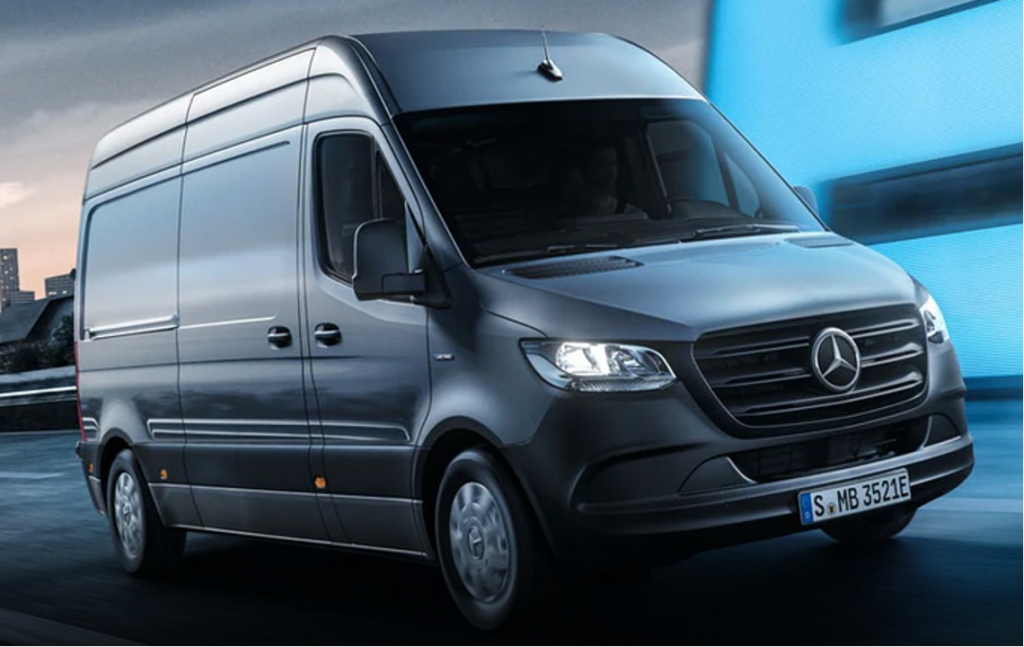
Autonomous vehicles: future reality or fantasy?
Recently, a lot of research effort has been invested into Autonomous Vehicle (AV) applications, focusing on mobility as a whole and logistics, both urban and long-haul. The following chapter provides an overview of innovations with logistic relevance and is based on ULaaDS Deliverable 3.1. So far, only a few of the applications are beyond the pilot phase and for most, the chances of adoption in the sector in the coming years are still highly uncertain.
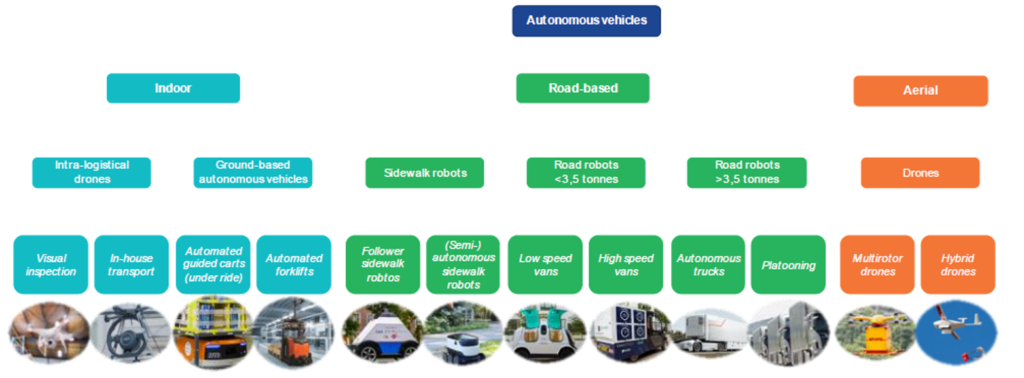
Of the many options, aerial AVs (drones) are being investigated as unmanned aerial vehicles for last-mile delivery, which, due to their limited volume, weight capacity and range, their inclusion in the urban freight transport network is not trivial. They could operate for last-mile delivery using a mobile depot for deliveries to customers. Regulatory and social concerns will be the main challenges for fast adoption, especially in Europe.
Road-based AVs range from small sidewalk robots to automated light commercial vehicles or even self-driving long-haul trucks. Some solutions are already being trialled, however fast adoption is still a substantial challenge, mainly due to regulatory and social concerns.
In the ULaaDS project, a solution based on the use of an autonomous vehicle provided by Easymile and operated by Ush has been successfully implemented. The goal of this trial was to test the possibilities of cargo-hitching with an autonomous vehicle used to transport both people and parcels; with an onboard parcel locker. The parcel locker was serviced by Bpost and passengers on the testing site were able to pick up parcels during the ride.
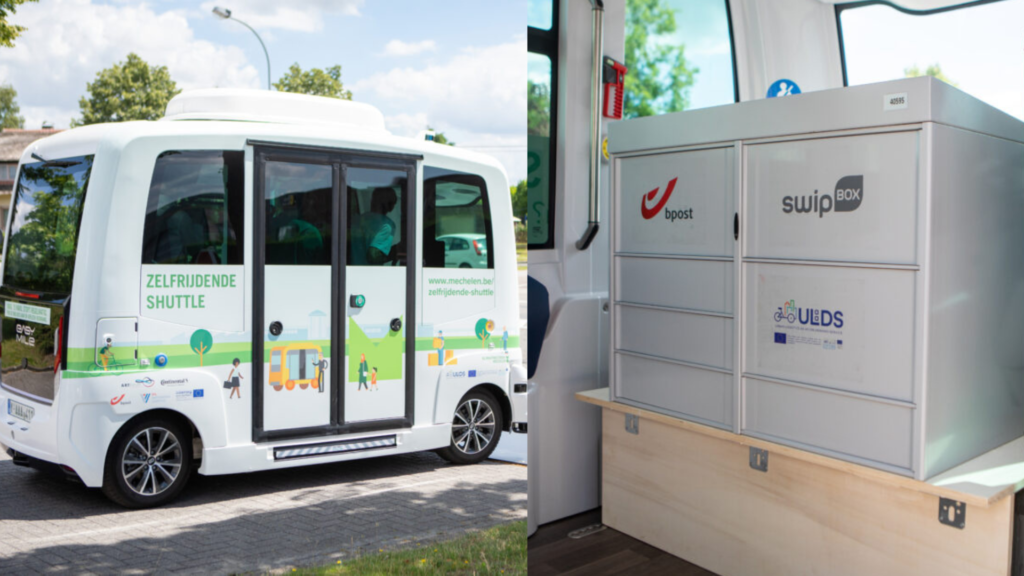
How to choose the right vehicle(s) for your fleet
When deciding to purchase sustainable vehicles for logistics services, two main aspects must be considered:
- Do the key attributes of the vehicle already fit my basic needs and requirements?
- What is the framework of the local logistics environment, how will it develop and how can precautionary measures be taken?
We will have to determine the best option among many key attributes by considering our current and future needs in order to ensure the vehicle’s lifetime is as long and useful as possible. Many topics come into play when making this decision, some of which are presented in the table below. Key attributes of the vehicles, which can contribute to the best decision to match the vehicle and needs perfectly, are also considered. For further information on what to consider for the diversification of a logistics fleet, check out this publication from the Urbanized project.
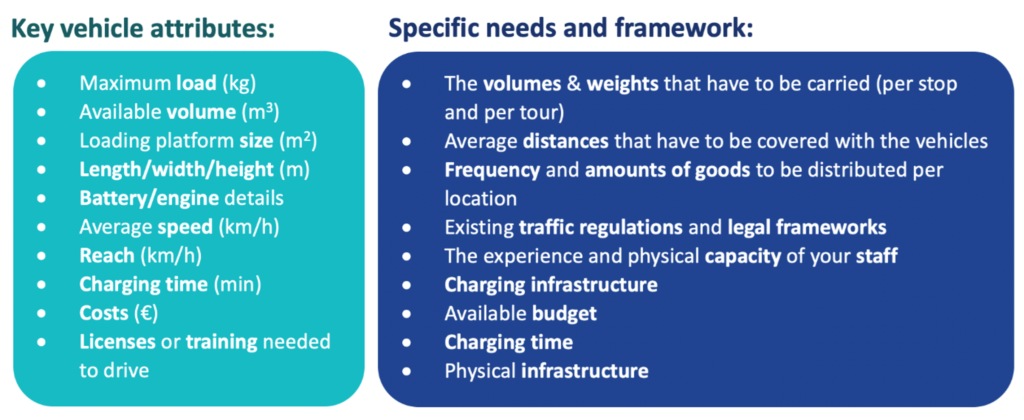
Building on these parameters, it will often already be possible to answer the question of which is the right vehicle for a logistics service and/or define what the best vehicle composition of a fleet is. For interested readers seeking more information about vehicle technologies, their pros and cons, or applications, ULaaDS offers a deeper insight in deliverable 3.1: Benchmarking & state-of-the-art.
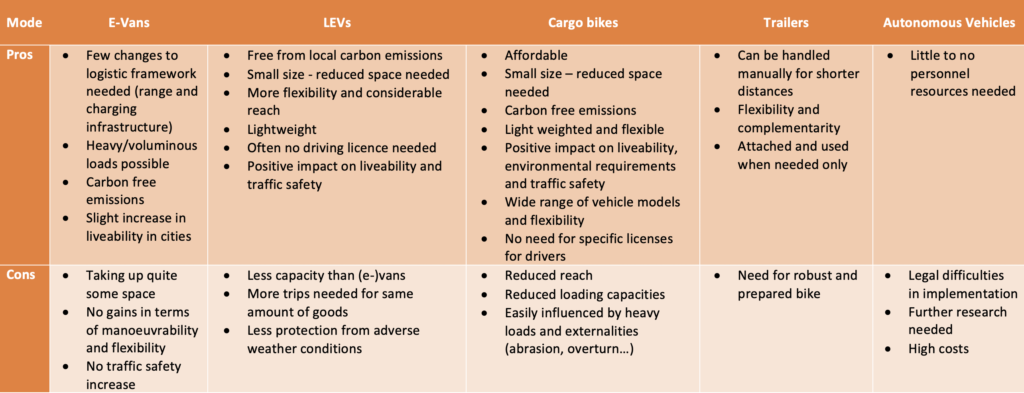
The ULaaDS Connection
As discussed, ULaaDS deliverable D3.1 goes into detail about several existing logistics operating models and vehicles, further analysed in ULaaDS trials. Accordingly, ULaaDS explores a variety of zero-emission vehicle solutions across some of its trials and use cases.
On a company site in Mechelen, an autonomous vehicle is picking up and delivering parcels and people for combined passenger and cargo transport, testing out cargo-hitching principles, as previously outlined.
In Bremen, Rytle cargo bikes and microhubs are used for the last-mile delivery of cargo. The bikes can transport pallets and large weight which is loaded onto the cargo bikes at different hub locations. The standardised pallet-size measurements of the cargo bike optimise the handling of goods in transport. Furthermore, cargo bikes will be added to the fleet offered by the free rental platform for private logistics, organised by ADFC.



